

The Indian River, in Dominica, is considered one of the major attractions for tourists. Since it empties into the only viable anchorage on the island, it is also popular with cruisers. Dominica, although a fairly impoverished island, is sometimes referred to as the island where nobody starves. This is due to a very lush rainforest full of fruits and vegetables. Things such as grapefruits, for example, are about eight cents US, and it is quite possible they overcharged us just because we are Americans. Even with prices so cheap, most people need some income, and Dominica only has a few large businesses (the largest being a Colgate factory) and unemployment is high. To earn a few dollars a day, a group of young men got together and formed the Indian River Guides association.
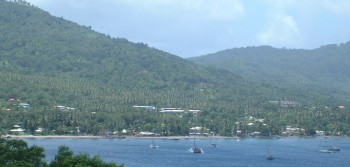 Prince Rupert Bay. The Indian River comes down between the two hills. Ocelot is on the far left |
Before the association, young men (often referred to as Ďboat boysí) with long rowboats were so eager for business that they would row out, often more than a mile, to hassle incoming yachts. To make matters worse, they were not likely to let you go easily, and were such a bother to deal with that many yachts simply didnít go to Dominica.
The association has made it much nicer to visit Dominica. The boat boys now have fairly large (25 to 75 HP) outboards on their twenty-foot-long, brightly painted wooden boats. This allows them to meet you further out then ever. However, they are much easier to deal with, as a major part of the associationís business is to train its people in interacting with the tourists. They still tend to swarm around incoming boats, but are now quite willing to leave them alone, especially if the boaters are already doing business with another boat boy. They are also generally very friendly, and often useful. Some of them will sell foods, jewelry, or anything else they think boaters might want. Some will offer delivery services, such as bringing food, water, or fuel, and/or taking back garbage or anything else you need taken ashore. Some will offer tours of the island, or invite you to restaurants. Nearly always, however, the most common offer is for the Indian River trip, which only these guides are allowed to take people on.
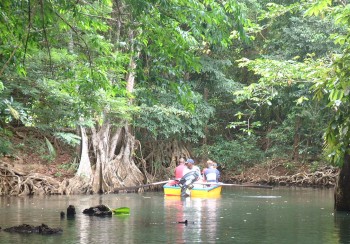 The Sea Eagle family on the Indian River with Alexis |
We had considered going up the Indian River from the time we arrived in Dominica. However, we had decided that if we went up at all, we would wait for our friends on Sea Eagle and go up together. The family on Sea Eagle agreed to this plan, and we took the trip the day they arrived.
Alexis and Raymond, the boat boys, came and picked us up at our boats. They took us to the mouth of the river in their brightly painted wooden boats using their outboards, but outboards are not allowed up the river so when they got to the bridge they had to row. They could only take five people at once, so our family went with one guide, and the family on Sea Eagle went with another. At the mouth of the river, our guides (Alexis and Raymond, the boat boys who had picked us up) moved to their rowing positions and started taking us upriver.
We learned from our guides (who receive training about the river from the association) that the Indian River got its name because when Europeans first discovered the island, there was a large colony of Caribs living on the banks. We also learned that while Dominica has a large number of rivers (especially for so tiny an island!) the Indian River is the only one that is easily navigable.
As they told us this, we were being rowed up into the forest. There wasnít much current, just the usual slow, steady flow of the river. The river was probably about thirty feet wide on average, but it changed a lot as we went further into the rainforest. There were lots of branches and lots of flowers growing along the banks, and a lot of mangroves and their roots (especially near the mouth.)
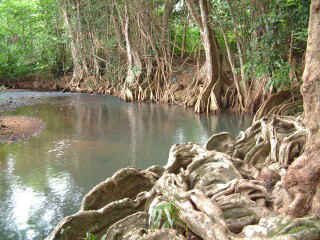 Wild roots along the river banks of the river |
Our guidesí boats were almost always within visual range of each other (not far on the winding and overgrown river,) so we noticed when the other boat stopped. We were ahead of them, but we drifted back to see what we had missed. High above our heads, two iguanas were sunning themselves on branches over the river. All we could see of them was round bulges were their sides hung over the sides of their perches, and their more pointed knees. From below, it almost looked like odd-shaped, symmetrical green growths on the branches. After we had watched them for a while (not that they did anything) we continued, now trailing somewhat behind the other boat.
We only saw those two iguanas, but there was lots of other animal life along the banks. We spotted numerous kingfishers and herons. In fact, they were fairly common. We saw them in the water, on the banks, on branches, and in the air. Sadly, it was hard to get a photo of them. The most common animals, however, were land crabs. They were all over the place, usually one or two in an area, but sometimes groups of maybe twenty. There were a few which were at least partly in the water, but for the most part they were on roots or dry land. Some of them were pretty big, with shells five to six inches across, and claws about half that long. The crabs were also quite colorful, ranging from a green-brown to reddish-purple.
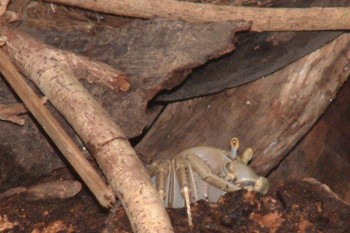 Land crab, hiding in the roots & mud along the bank |
The rainforest was really thick. Most places, you couldnít see more than about ten feet in from the river bank, at least not from down in the boat. The trees often grew out over the river, so even when it rained (and it did a few times, though only lightly) the branches sheltered us. There were only a few human signs along the river, making the rainforest all the more beautiful. We heard the calls of many birds, and occasionally other animal noises, but the sound of the oars in the water was the only human sound most of the time.
The plants were large and plentiful. Along the banks or up in the little bit of the canopy visible from the river, we could see gorgeous flowers. Huge vines, some along tree trunks and some just hanging out of or between trees, were everywhere. We saw lots of huge leaves, and some were so large it was hard to tell what they were connected to. There were also lots of epiphytes on the sides of the trees, looking like bright, crazy birdsí nests. Altogether, the river was covered in color, the many shades of green and brown accenting the bright colors of flowers, buds, berries, and fruits. The river smelled of tropical flowers and fruits, mud from the riverbanks, and fresh, unpolluted air. As Raymond rowed us up, we were able to relax and enjoy the forest.
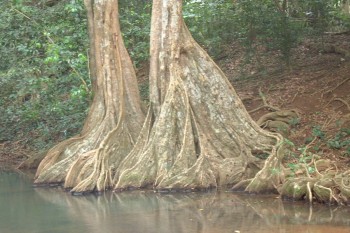 Buttressed roots along the banks of the Indian river |
The further upriver we went, the narrower and shallower it got. Consequently the river flowed faster, and we had to dodge more obstacles. This did let us get a closer look at the banks, however. The banks mostly fell into one of two categories: roots or mud. The land crabs scuttled over both, and my mom had the camera out all the time, trying to get a picture of them. I was more interested in the shore itself. I found that the reason it was hard to see into the forest was not because of groundcover, such as recent regrowth, but because the trees, roots, vines, and leaves formed a solid barrier. The only ground level plants were out on the riverbanks, where they could get sun without being completely overshadowed by the canopy of trees. I read once that only about one percent of sunlight actually penetrates the canopy of a tropical rainforest. Looking into that dimly lit jungle, Iím not surprised. My mom and dad worked hard to get these photos. The ground itself was mostly mud or slightly dryer dirt, usually with slowly decomposing leaves scattered over it. The only other things were trees that must have been hundreds of years old, with trunks sometimes more than ten feet across, and reaching hundreds of feet high. In the distance, I could see the tops of even taller trees.
Iím not sure how long or how far we went on the river, but eventually we reached our destination: a small dock, with the other boat already tied up at it, and a cleared area with an awning over it. There was a little bar/restaurant and some tables under the awning, and the guides went up and sat together with some other locals, chatting. We all did some exploring, and Chrissy from Sea Eagle got out her sketchbook and started to sketch the forest.
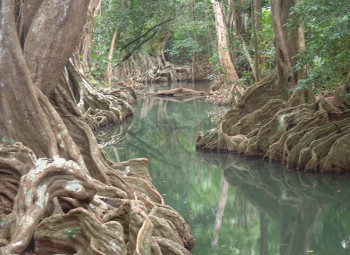 The peaceful serenity of the Indian River |
We didnít spend long at the top, probably less than a half hour. This time, we went with all the kids in one boat, and the adults in the other. Our boat launched a bit before the other, and we had a nice, leisurely ride back out towards the sea. To make the return a bit different, our guide also rowed us up a little side stream that I had noticed on the way up. It was too crowded with debris to go far, but it was it was so narrow that the rainforest could reach across it. There was no noise except for the animals, and the treetops blocked almost all the light. We probably only spent a minute or two up that stream, but I remember it clearly.
As we came out of the side stream, we rejoined the adults boat, and our guides rowed us back out to the river mouth. The iguanas were still in their tree, and the birds and land crabs were still all over the place, but we saw almost nothing we hadnít seen before. When we got back to the bridge that marked the mouth of the river, our guides stowed their oars and moved back to the engines. The startling noise of the outboards was the signal that we had left the jungle, and returned to the 21st century.
Top Level: Home | Destinations | Cruising Info | Underwater | Boat Guests | Ocelot | Sue | Jon | Amanda | Chris | Site Map | Make a Comment
|
If our information is useful, you can help by making a donation |
Copyright © 2000‑ Contact: Jon and Sue Hacking -- HackingFamily.com, svOcelot.com. All rights reserved.